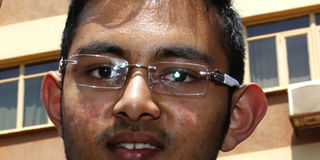List: Best UACE results posted in five years

Jay Patel of Makerere College in Kampala got 20 points in PCM PHOTO BY ABUBAKER LUBOWA.
What you need to know:
Boys continue to outshine girls in sciences, meaning marketable sciences courses such as Medicine, Architecture, Engineering, among others, will continue to register fewer females
KAMPALA.
The Uganda Advanced Certificate of Education (UACE) results released by Uganda National Examinations Board (Uneb) on Friday put the candidates’ overall performance at 98.4 per cent.
The performance means that 59.8 per cent (64,132) of the candidates qualified for direct entry to university and other candidates (87, 826) or 81.9 per cent qualify for other tertiary courses since they scored one principle pass and two subsidiaries.
But how has the performance been like for the last five years?
Like in every competition, the competitors aim at a prize. In 2013, of the 4,372 candidates who sat for examinations, Uneb reported that 97.4 per cent of candidates had qualified to join a higher institution of learning.
In 2011, 99.2 per cent of 103,760 candidates who registered for UACE examinations from 1,334 centres passed the examinations, representing an increase of 2.2 per cent in 2010, according to Uneb statistics.
In 2009, Uneb registered a 98.6 per cent pass mark of the students who were examined, a slight improvement, compared to 98.2 per cent in 2008.
Boys continue to outshine girls in sciences, meaning marketable sciences courses such as Medicine, Architecture, Engineering, among others, will continue to register fewer females.
According to Uneb secretary Mathew Bukenya, examinations are aimed at testing “candidates’ ability to comprehend and apply knowledge in new situations, demonstrate analytical skills and ability to carry out scientific experiments”, among others.
The better performance is attributed to students’ improvement in the above.
However, students testing are done only at the end of a cycle of education and are intended to help primarily as instruments for certification and selection of learners into institutions of higher learning, meaning the results may not truly represent students’ competence.




